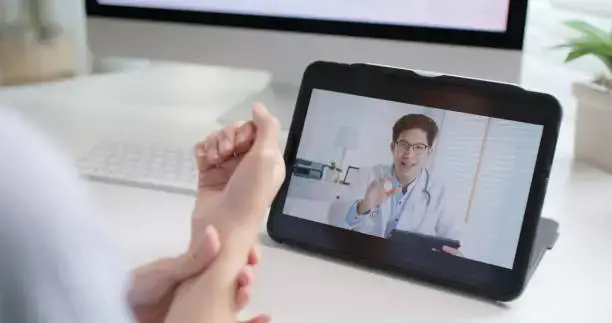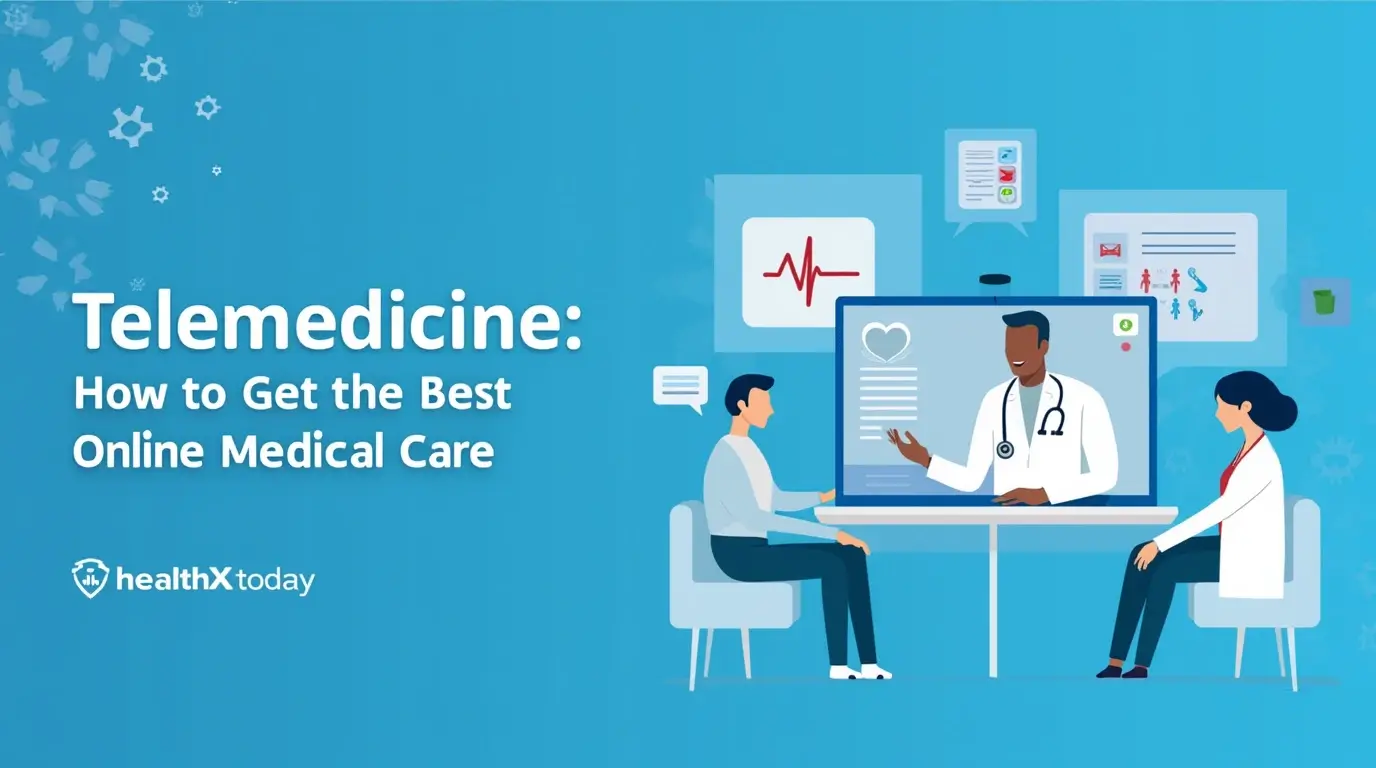We envision a world where everyone has the tools and knowledge to live a balanced, healthy, and fulfilling life. By providing reliable resources, personalized programs, and community support, we aim to be a beacon of hope for those on their health journey.
Table of Contents
Introduction to Telemedicine

Telemedicine refers to the practice of delivering healthcare services remotely through the use of telecommunications technology. This innovative approach enables healthcare providers to evaluate, diagnose, and treat patients without the need for an in-person visit. The evolution of telemedicine has reshaped how medical care is accessed and delivered, offering significant advantages in terms of convenience, efficiency, and accessibility.
Historically, telemedicine can be traced back to the early 20th century when healthcare practitioners began using radio and telephone communications to share patient information and provide consultation services. Read : Best Mental Health Apps to Boost1 Your Well-Being now; However, it wasn’t until the late 1990s and early 2000s that advancements in internet technology laid the groundwork for the modern telemedicine we recognize today. The development of high-speed internet, video conferencing, and mobile applications has revolutionized telehealth, making remote healthcare solutions more viable and practical.
Central to telemedicine’s rise are several key technologies that facilitate remote consultations and digital health services. These include video conferencing tools, patient portals for secure communications, mobile health apps, and wearable devices that monitor health metrics in real-time. These technologies empower providers to conduct virtual visits that are not only cost-effective but also able to reach patients in underserved or rural areas where access to traditional healthcare facilities may be challenging.
As the landscape of healthcare continues to evolve, telemedicine has gained even greater relevance, particularly in light of global health challenges and the increasing demand for patient-centered care. The COVID-19 pandemic accelerated the adoption of telemedicine, as many healthcare systems recognized the need for alternative modes of service delivery to protect both patients and providers. This transformative impact illustrates how telemedicine is not merely a trend but a fundamental shift in the way healthcare is approached, ensuring that it remains accessible and efficient in an ever-changing environment.
Benefits of Telemedicine
Telemedicine has rapidly transformed the landscape of healthcare delivery, presenting numerous benefits that enhance the overall patient experience and outcomes. One of the primary advantages of telemedicine is improved access to healthcare services. Individuals who live in remote or underserved areas often face significant barriers when trying to receive medical attention. Telemedicine breaks down geographic barriers, allowing patients to consult with healthcare providers from the comfort of their own homes, thus broadening the reach of healthcare services.
Another notable benefit is the convenience telemedicine offers to patients. With the ability to schedule appointments and receive consultations virtually, patients can save time that would otherwise be spent traveling to medical facilities. This ease of access is particularly beneficial for those with mobility issues or complex schedules, enabling them to seek medical advice without added stress.
Moreover, telemedicine significantly reduces waiting times for appointments. Traditional healthcare often involves long waits, both for scheduling and on the day of the visit. Telemedicine allows for quicker consultations, which can lead to faster diagnoses and treatment plans, ultimately improving patient satisfaction. Additionally, reduced waiting times can alleviate the strain on healthcare facilities, leading to more efficient use of resources.
Cost-effectiveness is another critical advantage of telemedicine. It can often reduce costs associated with in-person visits, such as transportation, missed work, and facility fees. As healthcare providers increasingly adopt telemedicine practices, patients may enjoy lower consultation fees, making access to necessary care more affordable.
Furthermore, telemedicine can enhance patient outcomes by facilitating continuous care and follow-up. With virtual platforms, healthcare providers can monitor patients more closely and offer timely interventions when needed. This ongoing support can lead to better management of chronic conditions, ultimately contributing to improved health outcomes. Through these multifaceted benefits, telemedicine is not just transforming healthcare access; it is setting new standards for efficiency and patient care.
Challenges and Limitations

Telemedicine has emerged as a transformative force in healthcare, offering unprecedented convenience and accessibility. However, it is not without its challenges and limitations. One significant barrier is the technological infrastructure required to support telehealth services. Many rural and underserved populations lack reliable internet access, which can hinder the ability to engage in virtual consultations. This digital divide raises concerns about equity in healthcare, as individuals without access to adequate technology may be marginalized in receiving medical attention, leading to disparities in health outcomes.
Privacy and security concerns represent another substantial challenge for telemedicine. As healthcare providers increasingly rely on digital platforms to deliver care, protecting patient data becomes paramount. The potential for data breaches or unauthorized access to sensitive health information could discourage patients from embracing telehealth. Additionally, the lack of robust regulatory frameworks can lead to inconsistencies in the protection of patient data across different telemedicine services, further complicating trust in this burgeoning sector.
Regulatory issues also pose a significant limitation to the broad implementation of telehealth services. Many regions face stringent regulations regarding the practice of medicine, which can restrict the ability of healthcare professionals to provide care across state or national borders. These legal constraints can inhibit the delivery of timely medical advice and treatment, ultimately affecting patient care. As healthcare systems adapt, it is crucial to establish clear guidelines and regulations that facilitate the seamless integration of telemedicine into existing healthcare frameworks while safeguarding patient rights.
In conclusion, while telemedicine holds great potential for transforming healthcare delivery, addressing these challenges is essential for ensuring equitable access and maintaining patient trust. Ongoing efforts are necessary to overcome technological barriers, enhance data security, and establish comprehensive regulatory frameworks to ensure that telehealth services can benefit all demographics effectively.
Technologies Driving Telemedicine
In recent years, telemedicine has gained significant traction, supported by various technological advances that have transformed healthcare delivery. At the forefront are video conferencing tools that allow healthcare providers to connect with patients in real-time, irrespective of their geographical locations. These platforms not only enable face-to-face consultations but also ensure that communication remains clear and effective. The importance of reliable video conferencing solutions cannot be overstated as they make virtual consultations a viable alternative to traditional in-person visits.
Additionally, mobile health applications play a pivotal role in the telemedicine landscape. These applications facilitate secure communication between patients and healthcare providers, provide easy access to health information, and enable patients to manage chronic conditions effectively. Users can schedule appointments, receive reminders, and even engage in virtual discussions regarding their health status. This level of interactivity fosters a continuous connection between patients and their care teams, thereby enhancing patient engagement and encouraging adherence to treatment plans.
Wearable devices also contribute significantly to the success of telemedicine. From fitness trackers to smartwatches, these devices can monitor vital signs and collect health data in real-time. This information can be shared with healthcare providers for monitoring and analysis, allowing for timely interventions when necessary. By integrating wearable technology into telemedicine practices, healthcare professionals can provide personalized care while keeping a close watch on their patients’ health metrics.
The combination of video conferencing, mobile health apps, and wearable devices has created an ecosystem that enhances patient-provider interactions. These technologies not only bridge the gap between healthcare access and efficiency but also empower patients, enabling them to take an active role in managing their health. As telemedicine continues to evolve, the integration of these technologies is likely to provide even greater advantages to both patients and healthcare systems.
Telemedicine in Different Specialties

Telemedicine has rapidly evolved and been adopted across various medical specialties, demonstrating its versatility and effectiveness in transforming the healthcare landscape. In primary care, telemedicine allows physicians to conduct routine consultations and follow-up visits without the need for in-person interactions. This not only increases accessibility for patients but also optimizes the use of healthcare resources, particularly in rural or underserved areas. Patients can receive timely advice for acute conditions, preventive care, and chronic disease management through virtual visits.
Mental health services have significantly benefited from the rise of telemedicine. The accessibility of mental health therapy and psychiatric consultations via video calls has been a game-changer, especially during the COVID-19 pandemic. Online platforms facilitate confidential interactions between therapists and patients, reducing barriers that previously hindered access to care. Research indicates that teletherapy can be as effective as in-person sessions, thereby encouraging individuals to seek help without the stigma often associated with mental health treatment.
In dermatology, telemedicine is utilized for evaluating skin conditions through high-resolution images. Patients can upload pictures of rashes, moles, or lesions, allowing dermatologists to provide timely assessments and treatment recommendations without the need for an office visit. This approach significantly speeds up diagnosis and increases the likelihood of early intervention for serious conditions like skin cancer.
Chronic disease management is another area where telemedicine excels. Patients with conditions such as diabetes or hypertension benefit from remote monitoring and virtual consultations, which encourage adherence to treatment plans and lifestyle modifications. Regular check-ins via telehealth provide an opportunity for healthcare providers to adjust medications, assess progress, and offer personalized health advice.
The integration of telemedicine across these specialties exemplifies its potential to enhance patient care, broaden access to healthcare services, and address the ongoing challenges faced by the traditional healthcare system. As telemedicine continues to evolve, its role in improving health outcomes across different fields will likely expand, offering a promising future for healthcare delivery.
Patient Experience with Telemedicine
The advent of telemedicine has revolutionized the way patients engage with healthcare services. Many individuals have shared their success stories, shedding light on their journey with remote healthcare consultations. One notable example is Jane, a mother living in a rural area who required immediate medical attention for her child’s ear infection. With limited access to local pediatricians, she turned to a telemedicine platform. Within minutes, she was connected with a qualified pediatric specialist who diagnosed the issue and prescribed medication, all without the need for an in-person visit. Jane reported a positive experience, emphasizing the convenience and stress relief that telemedicine provided during a critical time.
Another example involves Mark, a middle-aged man managing a chronic condition. He initially approached telemedicine with skepticism, fearing that a virtual appointment would lack the personal touch and thoroughness of a traditional in-office visit. However, he found that the process was straightforward and effective. Mark appreciated being able to discuss his symptoms in a comfortable environment where he felt at ease and was impressed by the physician’s ability to manage his health needs remotely. He noted improved communication with his physician, as he could message them directly through the platform for follow-up questions without waiting for an appointment.
Despite the overwhelmingly positive experiences, some patients have expressed challenges. Technical difficulties, such as poor internet connectivity or unfamiliarity with the telehealth platform, have led to frustrations. Others have voiced concerns regarding the lack of physical examinations, which can sometimes limit the effectiveness of diagnosis. Nevertheless, the majority of feedback highlights that telemedicine has enhanced accessibility to healthcare providers, allowed for swift consultations, and improved overall patient satisfaction. These testimonials illustrate the transformative potential of telemedicine in delivering healthcare services effectively and efficiently.
The Role of Policies and Regulations

The regulatory landscape governing telemedicine has undergone significant transformation, especially in the wake of the COVID-19 pandemic. Before this global health crisis, telemedicine faced various hurdles, including stringent licensing requirements, reimbursement challenges, and inconsistent policies across states and countries. However, the urgent need for remote healthcare during the pandemic catalyzed major policy shifts designed to facilitate wider access to telehealth services.
One of the most notable changes was the temporary relaxation of licensing requirements. Previously, healthcare providers were often restricted to practicing medicine only within the state where they were licensed. In response to the pandemic, many states enacted emergency measures allowing practitioners to provide telemedicine services across state lines, thus expanding care access to patients in need. This shift not only addressed immediate health concerns but also sparked discussions regarding the long-term implications of more flexible licensing regulations to support telemedicine’s growth.
Additionally, reimbursement practices have evolved significantly. Many insurers, including Medicare and Medicaid, expanded their coverage for telehealth services, ensuring that providers would be compensated fairly for remote consultations. This expansion included not only video calls but also phone consultations and remote monitoring, which were previously less commonly reimbursed. As telemedicine continues to take root, ongoing discussions regarding equitable reimbursement practices are essential to ensure that it remains a viable option for healthcare providers and patients alike.
Furthermore, regulatory bodies are continually adapting their frameworks to address the unique challenges posed by telemedicine. This includes developing guidelines for patient privacy, consent, and data security, all of which are critical in maintaining trust in telehealth services. The interplay between policies and telemedicine will be crucial as the sector matures, balancing necessary regulations while fostering innovation in healthcare delivery.
Future of Telemedicine
The future of telemedicine presents an exciting landscape shaped by rapid technological advancements and evolving healthcare delivery models. As we look ahead, it is clear that the integration of artificial intelligence (AI) and machine learning will play a pivotal role in transforming how telemedicine services are delivered. These technologies have the potential to enhance diagnostic accuracy, streamline administrative processes, and personalize patient care, thereby contributing to a more efficient healthcare system.
One significant development on the horizon is the increased use of predictive analytics powered by machine learning algorithms. By analyzing vast amounts of patient data, AI can help identify trends and potential health risks before they escalate into more serious conditions. This proactive approach aims to not only improve patient outcomes but also reduce healthcare costs in the long run. Furthermore, AI-driven chatbots and virtual assistants are expected to become commonplace, providing immediate support and guidance to patients while freeing healthcare professionals to focus on more complex cases.
In addition to technological integration, the ongoing changes in healthcare delivery models are poised to reshape the future of telemedicine. The COVID-19 pandemic has accelerated the adoption of telehealth services, and many of these changes are likely to become permanent. As a result, patients will increasingly expect seamless access to virtual consultations, remote patient monitoring, and digital health tools. The shift towards value-based care will further encourage healthcare providers to adopt telemedicine solutions, as they seek to improve patient satisfaction and health outcomes.
Overall, as telemedicine continues to evolve, it will no doubt expand its reach and accessibility, fundamentally altering the healthcare landscape in the coming decade. By leveraging advanced technologies and adapting to new care models, telemedicine can offer innovative solutions that enhance patient experiences and improve population health.
Conclusion
In recent years, tele-medicine has emerged as a transformative force within the healthcare landscape, offering numerous advantages that cater to diverse patient needs. As detailed throughout this blog post, tele-medicine provides accessibility to medical care, particularly for those in rural or underserved areas. The convenience of virtual consultations eliminates barriers such as travel time and long waiting periods, allowing patients to seek medical advice from home. This evolution in how healthcare services are delivered not only enhances patient satisfaction but also promotes timely interventions, which can be critical in managing chronic conditions.
Furthermore, the technological advancements that support tele-medicine—such as improved video conferencing tools, mobile health applications, and secure online platforms—empower both healthcare providers and patients. These innovations contribute to efficient healthcare delivery by facilitating real-time communication and data sharing, leading to better-informed medical decisions. The rise of tele-medicine has also prompted healthcare systems to adopt more flexible approaches, allowing for the integration of telehealth services into traditional practices.
As we navigate through these changes, it is essential for patients to stay informed about the potential benefits and limitations of tele-medicine. The importance of telehealth cannot be overstated, as it allows individuals to manage their healthcare more effectively, especially in times of crisis. By embracing tele-medicine, patients open themselves up to a new realm of healthcare possibilities that prioritize convenience and personalized care. Thus, considering tele-medicine as a viable option for healthcare needs may greatly enhance patient experiences and outcomes. It is imperative for individuals to continue engaging with the evolving nature of tele-medicine, ensuring they are well-prepared to take advantage of its full potential.
Did You Try this tips ?
There are no reviews yet. Be the first one to write one.
blood work brain health cancer treatment climate health diabetes treatments digestive health disease management disease mapping exercise plan fitness tips gut health hair care hair growth hair treatment health foods health insurance health tips healthy habits healthy recipes heart disease home workouts immune boost immune foods keto plan keto recipes kidney disease lifestyle diseases meal delivery medicine innovation melanoma treatment mental health morning exercise natural remedies non melanoma nutritional advice nutrition assistance raw nutrition skin cancer skin care skin health sleep exercise sleep technology telemedicine services viral threats weight loss








